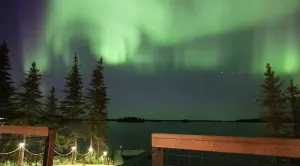
Dazzling biodiversity of Costa Rica: From colourful rainforest to sandy beaches
Millions of years ago, the shifting tectonic plates that connected North and South America, forming Costa Rica, created a remarkable opportunity for the flora and fauna of both continents to mingle for the first time. This geography changed the weather, where warm and moist sea air pushed up against the tall mountains, generating considerable rainfall spread across diverse ecosystems. It’s a sight to behold.
Millions of years ago, the shifting tectonic plates that connected North and South America, forming Costa Rica, created a remarkable opportunity for the flora and fauna of both continents to mingle for the first time. This geography changed the weather, where warm and moist sea air pushed up against the tall mountains, generating considerable rainfall spread across diverse ecosystems. It’s a sight to behold.
The mountains dip and weave through the country's central interior, reaching over 3000 meters in their tallest spots. That is the equivalent of stacking six CN Tower's. The heat, rain, volcanic-rich soil, and a wide range of geographical features augment the country's biodiversity and make it one of the richest on the planet. In such a small country, the area is home to 6% of the world's biodiversity, including areas such as Arenal Volcano National Park at the eastern foot of Lake Arenal, a massive 86-square-kilometre lake.
A guided tour is the best way to experience Costa Rica's biodiverse flora, fauna and landscape. Companies like Collette offer travel packages that not only offer guided tours but also find the best local guides for you. These guides are not just experts in biodiversity but also socially responsible and willing to share generations of knowledge that only a local guide can. Their expertise will ensure you have a comprehensive and enriching experience. Here is a glimpse of what you'll experience in this tropical and biodiverse paradise.
Flora
An astonishing half a million species, many of which are plants, live in Costa Rica. It would take a life's work to list and describe them all. This lush exotic diversity provides a backdrop that is a feast for the eyes, sweetened by 9000 flowering plant and tree species featuring every colour of the spectrum, from the deepest reds to the most vibrant yellows.
It's like the country is one giant royal botanical garden with striking orchids, lobster claw-shaped heliconias, and thousands of bromeliad species that show off colourful rosettes that look like an alien jungle plucked from a science fiction film. If you're fortunate, you may see a Dutchman's Pipe. These butterfly-attracting flowers grow on vines with blooms that grow to 20 centimetres in length. Vibrant green ferns and towering kapok trees with an impressive width scrape the top of the canopy, while a diverse range of trees, such as the umbrella-like cecropia tree, is a sloth's favourite. The Guanacaste tree, Costa Rica's national tree, cascades out with mushroom-shaped greenery that is wider than the tree's already impressive height. Its seeds are famous for being shaped like ears.
Cloud Forests

(Photo credit: Collette)
The cloud forest, such as the Monteverde Cloud Forest Reserve, is a spectacular part of Costa Rica's biodiversity. These rare forests grow where the weather creates steady cloud cover conditions. The sun is rarely allowed to break through the clouds, which slows down water evaporation, making the damp conditions that the species of trees, plants and animals that live here love.
In Monteverde, take a leisurely walk along hanging bridges where there is every type of vegetation imaginable, including epiphytes—plants that grow on other plants in a forest decorated by waterfalls and creeks. Or zipline through the canopy for an eagle's view. There is a host of species you won't see anywhere else on the planet. Monteverde Cloud Forest Reserve is an exclusive environment, a privilege to visit, where all six cat family species live—ocelots, oncillas, pumas, margays, jaguarundis, and the crowd-pleasing jaguars.
Mangroves

(Photo credit: Getty Images)
Costa Rica hosts mangroves on both the Pacific and Atlantic coasts, where freshwater streams meet the salty ocean. Species of mangrove trees spring from the brackish water with spider-leg-like roots that thrive on drinking the salty waters. This ecosystem is a nursery for Costa Rica's diverse marine life, such as crustaceans, caimans, multi-coloured amphibians, crocodiles, and countless tropical fish and birds, such as herons, cuckoos and hummingbirds. The mangrove's waterways that snake through the foliage are delicate, intimate and otherworldly.
Coastal Beaches

(Photo credit: Getty Images)
The 1,228 km of coastline surrounding Costa Rica features white and black sandy beaches that contribute to its rich biodiversity under the sun. The marine life is varied, from whales and dolphins to sea birds, with some of the most underrated bird watching in the country. Coral reefs offer snorkelers and divers an opportunity to see exotic fish, manta rays, and sharks, including hammerheads.
Tropical Rainforests

(Photo credit: Collette)
Costa Rica's tropical rainforests are plentiful, stretching along the Atlantic coast lowlands and the South Pacific. They are made of layers with a dense canopy formed by hundred-foot trees that help cool down the forest floor for smaller plants and vines to grow. Combined, they keep the air clean and rich with oxygen—the lungs of the earth.
The country’s rainforests are teaming with life, containing a dense variety of 12,000 plant species and thousands of animal species that change depending on the location. There is so much life that new species are constantly being discovered. This is why Costa Rica has designated large rainforest areas as nature reserves and natural parks. Approximately 25% of the country is protected. There are too many rainforests to list, but look for eco-conscience tour companies like Collette, which will take you into the heart of places such as Tortuguero National Park while respecting and preserving these natural wonders.
(Header image courtesy of Getty Images)









